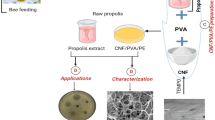Abstract
Honey bee propolis extract (HBP) was prepared by three methods; namely, soxhlet-reflux, magnetic stirring and ultrasound extraction. Based on the efficacies of HBP formation, the soxhlet-reflux method gave the highest yield of HBP. Electrospinning of cellulose acetate (CA) solution loaded with different concentrations of HBP was assessed. The results show that the surface morphology of CA nanofibers characterized by SEM changes with the addition of HBP to CA solution. The thermal stability of the as-formed CA/HBP marginally increases when compared with CA nanofibers. It was also observed that the CA/HBP nanofibers are effective inhibitors of growth of Escherichia coli (E. coli) and Staphylococcus aureus (S. aureus). Additionally, the in vitro release results of HBP from CA nanofibers displayed that the HBP release is sustained and controlled in neutral pH rather than alkaline and acid pH.
Graphical abstract









Similar content being viewed by others
Change history
16 September 2022
A Correction to this paper has been published: https://doi.org/10.1007/s10570-022-04793-2
References
Abdelgawad AM, El-Naggar ME, Hudson SM, Rojas OJ (2017) Fabrication and characterization of bactericidal thiol-chitosan and chitosan iodoacetamide nanofibres. Int J Biol Macromol 94:96–105
Bhardwaj N, Kundu SC (2010) Electrospinning: a fascinating fiber fabrication technique. Biotechnol Adv 28:325–347
Castillo-Ortega M, Nájera-Luna A, Rodríguez-Félix D, Encinas J, Rodríguez-Félix F, Romero J, Herrera-Franco P (2011) Preparation, characterization and release of amoxicillin from cellulose acetate and poly (vinyl pyrrolidone) coaxial electrospun fibrous membranes. Mater Sci Eng C 31:1772–1778
Chan GCF, Cheung KW, Sze DMY (2013) The immunomodulatory and anticancer properties of propolis. Clin Rev Allergy Immunol 44:262–273
Chen J-Y, Chen H-C, Lin J-N, Kuo C (2008) Effects of polymer media on electrospun mesoporous titania nanofibers. Mater Chem Phys 107:480–487
de Lima GG, de Souza RO, Bozzi AD, Poplawska MA, Devine DM, Nugent MJ (2016) Extraction method plays critical role in antibacterial activity of propolis-loaded hydrogels. J Pharm Sci 105:1248–1257
El-Feky GS, Sharaf SS, El Shafei A, Hegazy AA (2017) Using chitosan nanoparticles as drug carriers for the development of a silver sulfadiazine wound dressing. Carbohydr Polym 158:11–19
El-Naggar ME, Abdelgawad AM, Salas C, Rojas OJ (2016) Curdlan in fibers as carriers of tetracycline hydrochloride: controlled release and antibacterial activity. Carbohydr Polym 154:194–203
El-Newehy MH, El-Naggar ME, Alotaiby S, El-Hamshary H, Moydeen M, Al-Deyab S (2016) Preparation of biocompatible system based on electrospun CMC/PVA nanofibers as controlled release carrier of diclofenac sodium. J Macromol Sci Part A 53:566–573
El-Newehy MH, El-Naggar ME, Alotaiby S, El-Hamshary H, Moydeen M, Al-Deyab S (2018) Green electrospining of hydroxypropyl cellulose nanofibres for drug delivery applications. J Nanosci Nanotechnol 18:805–814
Fathi-Azarbayjani A, Qun L, Chan YW, Chan SY (2010) Novel vitamin and gold-loaded nanofiber facial mask for topical delivery. AAPS Pharmscitech 11:1164–1170
Ghisalberti E (1979) Propolis: a review. Bee world 60:59–84
Hebeish A, El-Rafie M, Rabie A, El-Sheikh M, El-Naggar ME (2014) Ultra-microstructural features of perborate oxidized starch. J Appl Polym Sci 131:40170–40179
Kim JI, Pant HR, Sim H-J, Lee KM, Kim CS (2014) Electrospun propolis/polyurethane composite nanofibers for biomedical applications. Mater Sci Eng C 44:52–57
Lagouri V, Prasianaki D, Krysta F (2014) Antioxidant properties and phenolic composition of Greek propolis extracts. Int J Food Prop 17:511–522
Li H, Xu Y, Xu H, Chang J (2014a) Electrospun membranes: control of the structure and structure related applications in tissue regeneration and drug delivery. J Mater Chem B 2:5492–5510
Li R, Dou J, Jiang Q, Li J, Xie Z, Liang J, Ren X (2014b) Preparation and antimicrobial activity of β-cyclodextrin derivative copolymers/cellulose acetate nanofibers. Chem Eng J 248:264–272
Liu Y, Nguyen A, Allen A, Zoldan J, Huang Y, Chen JY (2017) Regenerated cellulose micro-nano fiber matrices for transdermal drug release. Mater Sci Eng C 74:485–492
Matei PM et al. (2015) Synthesis of chitosan oligomers/propolis/silver nanoparticles composite systems and study of their activity against Diplodia seriata. Int J Polym Sci 2015:1–11
Meng C et al (2015) Activation of cellulose by supercritical tetrafluoroethane and its application in synthesis of cellulose acetate. Ind Eng Chem Res 54:12204–12213
Popova M, Silici S, Kaftanoglu O, Bankova V (2005) Antibacterial activity of Turkish propolis and its qualitative and quantitative chemical composition. Phytomedicine 12:221–228
Rogina A (2014) Electrospinning process: versatile preparation method for biodegradable and natural polymers and biocomposite systems applied in tissue engineering and drug delivery. Appl Surf Sci 296:221–230
Schreuder-Gibson HL, Truong Q, Walker JE, Owens JR, Wander JD, Jones WE (2003) Chemical and biological protection and detection in fabrics for protective clothing. MRS Bull 28:574–578
Sharaf S, Higazy A, Hebeish A (2013) Propolis induced antibacterial activity and other technical properties of cotton textiles. Int J Biol Macromol 59:408–416
Wang J, Windbergs M (2017) Functional electrospun fibers for the treatment of human skin wounds. Eur J Pharm Biopharm 119:283–299
Acknowledgments
This project was supported financially by the Science and Technology Development Fund (STDF), Egypt, RSTDG, Grant number 14918.
Author information
Authors and Affiliations
Corresponding author
Additional information
The original online version of this article was revised: Figure 3 is updated.
Electronic supplementary material
Below is the link to the electronic supplementary material.
Rights and permissions
About this article
Cite this article
Sharaf, S., El-Naggar, M.E. Eco-friendly technology for preparation, characterization and promotion of honey bee propolis extract loaded cellulose acetate nanofibers in medical domains. Cellulose 25, 5195–5204 (2018). https://doi.org/10.1007/s10570-018-1921-1
Received:
Accepted:
Published:
Issue Date:
DOI: https://doi.org/10.1007/s10570-018-1921-1




